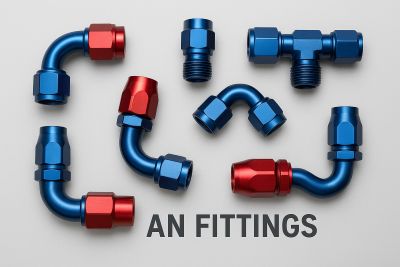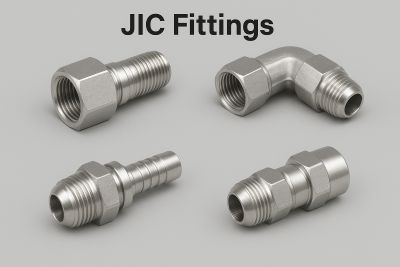In hydraulic and automotive systems, fittings play a crucial role in preventing leaks and ensuring reliable performance. These small but vital components keep fluid systems secure under immense pressure and vibration.
AN (Army-Navy) and JIC (Joint Industry Council) fittings look nearly identical, both use a 37° flare for sealing, which often leads to one key question: are they interchangeable?
This article explores whether AN and JIC fittings can truly be used interchangeably, explaining their key differences, similarities, and the conditions under which mixing them is (and isn’t) safe.
In short, while AN and JIC fittings share many characteristics, their manufacturing tolerances and intended applications differ, and those differences matter.
What Are AN Fittings?
AN fittings originated from U.S. military specifications during World War II, developed for aircraft hydraulic systems where performance and safety were paramount. “AN” stands for Army-Navy, and the fittings follow precise military standards to ensure compatibility and reliability under extreme conditions.
Design Features:
➡️ 37° flare angle for a secure metal-to-metal seal
➡️ Extremely tight manufacturing tolerances
➡️ Typically made from high-grade aluminum or stainless steel
➡️ Designed to resist vibration, pressure spikes, and fatigue
Common Uses:
AN fittings are widely used in aviation, motorsports, aerospace, and performance automotive applications, where reliability under stress is non-negotiable.
Pressure Ratings and Reliability:
Due to their strict tolerances, AN fittings can handle high pressure and vibration with minimal risk of leakage, making them the standard for critical systems.
What Are JIC Fittings?
JIC fittings, short for Joint Industry Council, are standardized under SAE J514 and ISO 8434-2. They were developed for industrial hydraulic systems to provide a reliable, reusable connection method.
Design Features:
➡️ Also use a 37° flare angle
➡️ Manufactured with slightly wider tolerances than AN fittings
➡️ Commonly made from steel, stainless steel, or brass
➡️ Designed for practical, cost-effective use in general hydraulic systems
Common Uses:
JIC fittings are widely found in industrial hydraulics, construction machinery, agricultural equipment, and factory systems, essentially, anywhere durability and ease of assembly are needed.
Pressure and Performance Range:
JIC fittings perform excellently in medium- to high-pressure applications but are generally not built for the extreme conditions that AN fittings must endure.
Similarities Between AN and JIC Fittings
Despite their different origins, AN and JIC fittings share several key characteristics:
1. 37° flare seat angle — ensures a tight, metal-to-metal seal.
2. Thread size and pitch — are typically identical for comparable sizes (e.g., -6 AN ≈ 9/16″-18 JIC).
3. Ease of assembly — both are wrench-tight connections that don’t require sealants or Teflon tape.
4. Material overlap — both are available in steel, stainless, and aluminum, depending on the use case.
These similarities often lead to confusion and the assumption that the fittings can be freely interchanged, but that’s not always the case.
Key Differences Between AN and JIC Fittings
|
Feature |
AN Fittings |
JIC Fittings |
|
Specification |
Military (SAE AS) |
Industrial (SAE J514) |
|
Tolerance |
Tight (for aviation use) |
Looser (for hydraulic systems) |
|
Cost |
Higher |
Lower |
|
Material Quality |
Typically higher-grade aluminum/stainless |
More varied |
|
Application Focus |
Precision and vibration resistance |
General-purpose hydraulics |
AN fittings are engineered for mission-critical applications with precise tolerances and premium materials. JIC fittings, while robust, are built for industrial versatility and affordability. The result? AN fittings offer more reliability under extreme vibration or pressure, but at a higher cost.
Are AN and JIC Fittings Interchangeable?
“Technically yes — but not always advisable.”
Because both fittings share the same thread size and 37° flare angle, they can be physically connected and often seal successfully, especially in low-stress conditions.
Why Caution Is Needed:
1. Tolerance mismatch: JIC fittings may not perfectly match AN flare surfaces, potentially causing minor leaks under high pressure.
2. Material hardness differences: Mixing soft aluminum AN fittings with hardened steel JIC fittings can damage the sealing surface.
3. Critical application risks: In aviation or racing, even minor leaks are unacceptable, so mixing standards isn’t recommended.
When Interchange Is Acceptable:
➡️ Low- to medium-pressure systems
➡️ Non-critical setups like test benches, shop tools, or prototype systems
When It’s Not:
➡️ High-performance or safety-critical systems (aviation, racing, aerospace)
➡️ Environments with extreme vibration or temperature
Best Practices for Using AN and JIC Fittings
Follow these best practices when using both AN and JIC:
1. Check specifications before mixing. Always verify the pressure, temperature, and material ratings.
2. Use matched materials to prevent galvanic corrosion (e.g., aluminum-to-aluminum).
3. Inspect sealing surfaces for scratches, dirt, or burrs before installation.
4. Use proper torque — overtightening can distort the flare, leading to leaks.
5. Replace rather than mix if reliability and safety are priorities.
Common Myths About AN and JIC Compatibility
Here are the common myths about AN and JIC compatibility:
“They’re exactly the same.”
→ False. They look similar but have different tolerances and specs.
“You can always mix them safely.”
→ Only in low-stress, low-pressure environments.
“Leaks only happen with bad assembly.”
→ Not true. Even perfect assembly can fail if materials or tolerances don’t match.
FAQs
Q1: Can I use JIC fittings on fuel lines?
Yes, you can, but it depends on the system’s pressure and safety requirements. For performance or aviation fuel systems, AN fittings are strongly recommended due to their tighter tolerances and reliability.
Q2: What’s the difference between JIC and SAE fittings?
JIC fittings use a 37° flare, while standard SAE flare fittings use 45°, making them not interchangeable.
Q3: How do I identify an AN fitting size?
AN fittings are measured in 1/16-inch increments. For example, a -6 AN fitting has a 6/16″ (or 3/8″) nominal size.
Conclusion
AN and JIC fittings share the same 37° flare design and similar thread dimensions, which makes them appear interchangeable. However, their manufacturing standards, tolerances, and materials tell a different story.
While they can sometimes be mixed in non-critical, low-pressure situations, doing so in high-performance or safety-sensitive systems can lead to leaks or mechanical failure.
If reliability, precision, and safety matter, use fittings that meet the same standard throughout your system. Mixing AN and JIC may work, but it’s not always worth the risk.
Post time: Nov-04-2025



